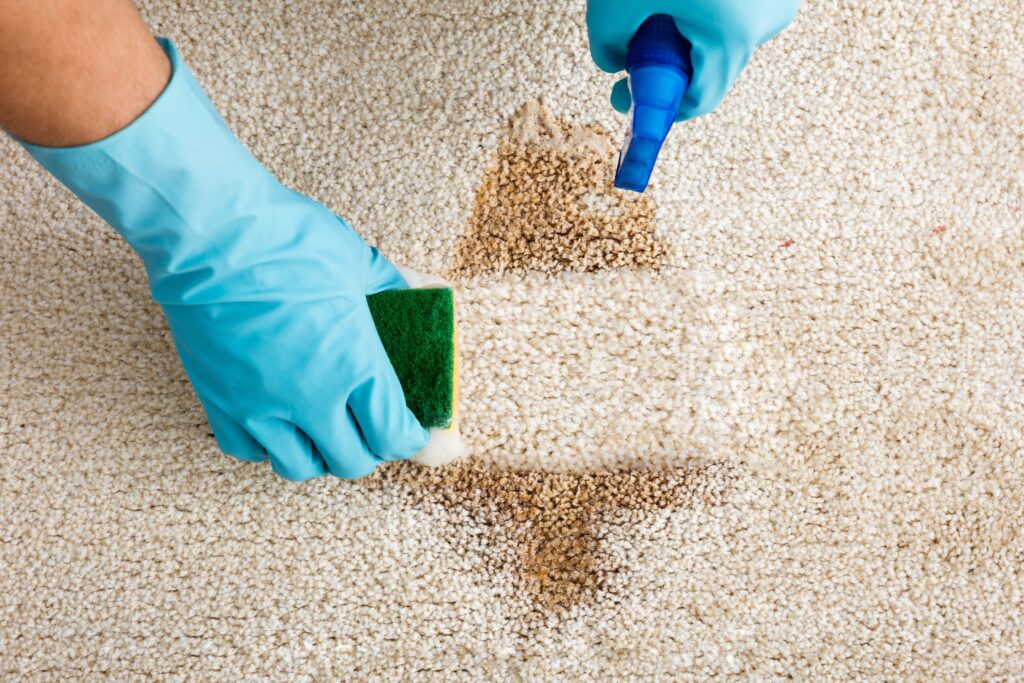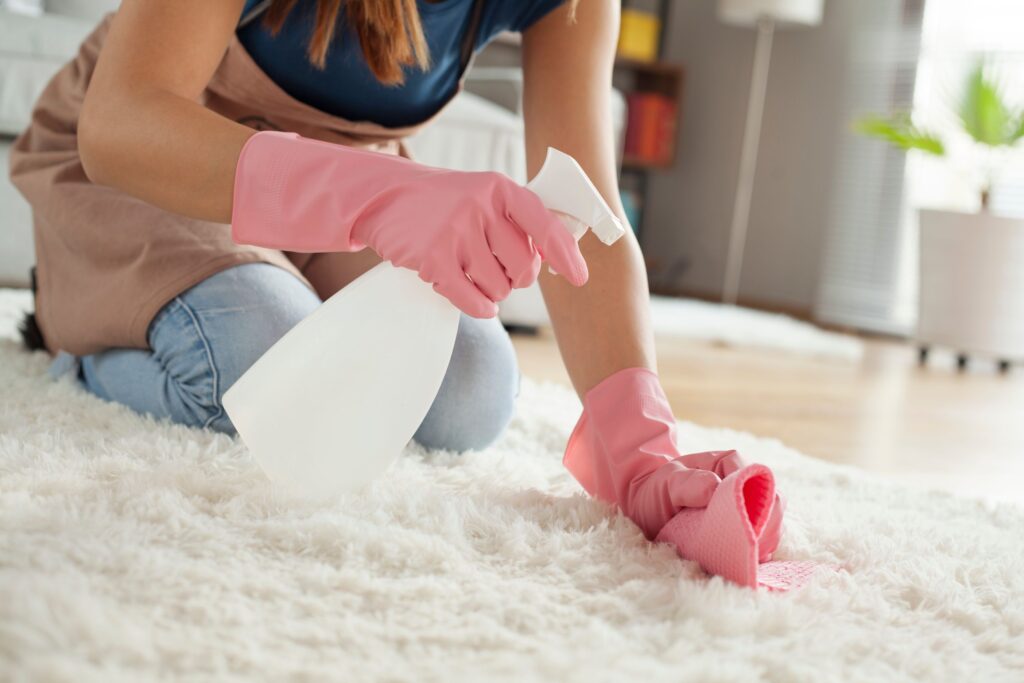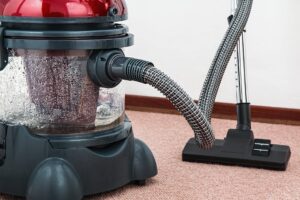Phoenix Tile Cleaning Services & Professional Carpet Cleaner
How to Disinfect Carpet Without Steam Cleaner
Carpets are often the unsung heroes of our homes, providing warmth, comfort, and an inviting ambiance to our living spaces. However, beneath their cozy exterior lies a hidden world of dirt, allergens, and germs that can accumulate over time. While vacuuming can help remove surface debris, deeper cleaning and disinfection are essential to maintain a healthy living environment. While many people turn to steam cleaners for the task, not everyone has access to one, and professional cleaning services can be costly. The good news is that you can effectively disinfect your carpet without needing a steam cleaner, thanks to simple do-it-yourself (DIY) methods and readily available household ingredients.
![]()

In this comprehensive guide, we’ll delve into the world of DIY carpet disinfection, offering you a range of techniques, tips, and tricks to help you achieve a clean, fresh, and germ-free carpet without the need for specialized equipment. Whether you’re dealing with stubborn stains, unpleasant odors, or simply want to ensure that your carpet is a healthy and hygienic part of your home, these methods will empower you to take matters into your own hands and transform your carpet into a pristine and welcoming surface once again. So, let’s embark on this carpet cleaning and disinfection journey, exploring the many effective ways to revitalize and maintain your beloved carpet without a steam cleaner.
How to Disinfect Carpet Without Steam Cleaner
Thoroughly disinfecting a carpet requires a combination of cleaning and sanitizing methods to ensure the removal of germs, bacteria, and allergens. Here’s the best way to disinfect a carpet:
Materials You’ll Need:
- Vacuum cleaner
- Carpet shampoo or cleaner (commercial or DIY)
- Hot water
- Baking soda
- White vinegar
- Essential oils (optional – for fragrance)
- A carpet brush or scrub brush
- A spray bottle
- Clean, dry cloths or paper towels
Step 1: Vacuum Thoroughly
Before you begin the disinfection process, vacuum your carpet thoroughly. Vacuuming eliminates loose dirt, dust, and debris from the surface, allowing the disinfectant to penetrate deeper into the carpet fibers.
Step 2: Pre-Treat Stains
Identify and pre-treat any visible stains or heavily soiled areas with a stain remover or a mixture of white vinegar and water. Then, allow it to sit for a few minutes before moving on to the next step.
Step 3: Prepare the Cleaning Solution
In a bucket, combine warm water with a carpet shampoo or cleaner according to the manufacturer’s instructions. You can also produce a DIY cleaning solution by combining the following:
- 2-3 tablespoons of baking soda
- 1/4 cup of white vinegar
- A few drops of your favorite essential oil (optional, for fragrance)
- 1 gallon of warm water
Step 4: Apply the Cleaning Solution
Dip a carpet brush or scrub brush into the cleaning solution and use it to scrub the carpet, starting in one corner and working your way towards the exit. Focus on high-traffic areas and any spots or stains.
Step 5: Allow Dwell Time
Let the the carpet absorb the cleaning solution for the recommended dwell time specified on the product label or for about 15-20 minutes if using the DIY solution.
Step 6: Rinse and Extract
Rinse the carpet thoroughly by using a clean cloth or sponge soaked in warm water. Alternatively, you may use a steam cleaner with plain hot water to rinse and extract the cleaning solution. Follow the manufacturer’s instructions for using the steam cleaner.
Step 7: Dry the Carpet
Use clean, dry cloths or paper towels to blot the carpet and absorb excess moisture. Open windows or use fans to expedite the drying process. Also, ensure the carpet is completely dry to prevent mold or mildew growth.
Following these steps can effectively disinfect your carpet, removing dirt, allergens, and harmful microorganisms. Regular maintenance and periodic deep cleaning using these methods will also help ensure a cleaner and healthier living environment.
Advantages of Disinfecting Carpet Without Steam Cleaner
Disinfecting a carpet without a steam cleaner offers several advantages, making it a practical and cost-effective option for many homeowners. Here are some of the key benefits:
1. Affordability
Steam cleaners can be expensive to purchase or rent, and professional steam cleaning services come with a price tag. However, disinfecting a carpet without a steam cleaner is budget-friendly, requiring only basic household items like baking soda, vinegar, and hydrogen peroxide.
2. Convenience
DIY carpet disinfection methods can also be done at your convenience without the need to schedule appointments with professional cleaners or rent specialized equipment. You can tackle carpet cleaning whenever it fits into your schedule.
3. Availability
Household items like baking soda and vinegar are readily available in most homes. You don’t need to invest in or rent specialized cleaning equipment, making the process accessible to many people.
4. Versatility
DIY methods offer flexibility in choosing the most suitable approach for your particular carpet cleaning needs. You can also tailor your disinfection process to address stains, odors, or general cleanliness.
5. Control
When disinfecting your carpet without a steam cleaner, you have direct control over the cleaning process. You can apply the cleaning solution to specific stains or areas that require more attention and adjust your efforts accordingly.
6. No Residue
Some steam cleaning methods may leave moisture and residue, requiring extended drying times. DIY carpet disinfection methods typically use minimal moisture, lessening the risk of mold or mildew growth and allowing for quicker drying.
7. Eco-Friendly Options
Many DIY carpet disinfection solutions use natural and environmentally friendly ingredients like vinegar and baking soda, reducing the use of harsh chemicals that may be found in commercial carpet cleaners.
8. Spot Cleaning
DIY methods are particularly effective for spot cleaning and treating localized stains or spills. You can address stains as they occur, preventing them from setting into the carpet fibers.
9. Maintenance
Regular DIY carpet disinfection can be incorporated into your cleaning routine, helping to maintain the overall cleanliness and hygiene of your carpet between professional cleanings.
10. Safety
DIY methods typically involve everyday household items that are safe for use in homes with children and pets. Worrying about exposing your family or pets to potentially harmful chemicals is unnecessary.
11. Customization
You can experiment with different DIY carpet cleaning solutions and techniques to find what works best for your specific carpet type and cleaning needs.
While DIY carpet disinfection without a steam cleaner offers numerous advantages, it’s essential to remember that deep cleaning and professional services are still necessary periodically to maintain your carpet’s long-term health and appearance. Nonetheless, these DIY methods can be invaluable for regular maintenance and addressing immediate cleaning and disinfection needs.

Disadvantages of Disinfecting Carpet Without Steam Cleaner
While disinfecting a carpet without a steam cleaner has its advantages, it’s essential to acknowledge the potential disadvantages and limitations of these DIY methods:
1. Limited Deep Cleaning
DIY methods may not provide the same level of deep cleaning as a steam cleaner. Steam cleaners can reach deep into the carpet fibers, extracting embedded dirt, allergens, and contaminants more effectively.
2. Ineffective for Large Areas
DIY methods can be time-consuming and labor-intensive for extensive carpeted areas or heavily soiled carpets. Achieving thorough disinfection on a large scale may require professional equipment.
3. May Not Remove Stubborn Stains
Some tough stains, such as old pet urine stains or red wine spills, may require the high-temperature steam and agitation a steam cleaner provides for complete removal.
4. Risk of Over-Wetting
DIY methods often use liquid solutions, and excessive moisture can harm carpets. Overwetting can also lead to mold or mildew growth, and it may damage the carpet backing or subfloor if not correctly managed.
5. Residue Build-Up
If not rinsed and extracted correctly, specific DIY cleaning solutions can leave behind residues that attract dirt and lead to rapid carpet re-soiling.
6. Potentially Lengthy Drying Times
DIY methods tend to use less moisture than steam cleaning, but drying times can still be extended, especially in humid environments. Prolonged dampness can be inconvenient and may pose a mold risk.
7. Limited Disinfection Power
While DIY solutions can effectively clean and refresh carpets, they may not provide the same level of disinfection and sanitization as high-temperature steam cleaning. It can be a concern if you require thorough disinfection, such as in healthcare or childcare environments.
8. Labor-Intensive
DIY carpet cleaning can be physically demanding, especially when scrubbing or blotting stains. It may not be suitable for individuals with mobility issues or physical limitations.
9. Risk of Color Fading
Some DIY solutions can affect the colorfastness of certain carpet types, potentially leading to fading or discoloration. Spot testing is essential to avoid this issue.
10. Potential for Uneven Cleaning
Inexperienced users may inadvertently apply DIY solutions unevenly, resulting in patches or streaks on the carpet’s surface.
11. Lack of Professional Expertise
DIY methods do not benefit from the experience and expertise of professional carpet cleaners who can identify specific carpet types and address unique cleaning challenges effectively.
In summary, while disinfecting a carpet without a steam cleaner offers cost-effective and convenient cleaning solutions, it may not be suitable for all situations. It is essential to assess your carpet’s size, condition, and specific cleaning needs before choosing a method. Professional steam cleaning services may be more effective and efficient for deep cleaning, extensive areas, or challenging stains.
Why Consider a Steam Cleaner to Disinfect Carpet
A steam cleaner, steam vacuum cleaner, or steam mop is a household appliance that uses hot steam to clean and disinfect various surfaces in the home. It is a versatile cleaning apparatus that can be used on multiple surfaces, including floors, carpets, upholstery, countertops, tiles, and more.
Here’s how a typical steam cleaner works:
1. Water Reservoir
Steam cleaners have a water reservoir or tank where you fill water. Some models may have additional compartments for specialized cleaning solutions or detergents.
2. Heating Element
Inside the steam cleaner is a heating element that heats the water to produce steam. The temperature of the steam varies, determined by the model but generally ranges between 200°F to 300°F or 93°C to 149°C.
3. Steam Generation
When the water reaches the desired temperature, it turns into steam and is expelled through a nozzle or a cleaning head.
4. Cleaning Head or Nozzle
The steam is directed onto the surface to be cleaned through a nozzle or a cleaning head. Additionally, some steam cleaners come with various attachments and accessories for different cleaning tasks.
5. Cleaning Action
The hot steam loosens dirt, grease, grime, and other contaminants on the surface. It also kills bacteria, germs, and dust mites through the combination of heat and moisture.
Steam cleaners are widely used for various cleaning tasks in homes and commercial settings due to their effectiveness in removing dirt, grime, and allergens and their ability to sanitize surfaces without using chemicals. They are handy for cleaning and disinfecting hard floors, tiles, grout, carpets, upholstery, and even some appliances.
Using a steam cleaner appropriately and following the manufacturer’s instructions to avoid damaging sensitive surfaces or materials is essential. Additionally, not all surfaces are suitable for steam cleaning, so it’s crucial to check the manufacturer’s recommendations and guidelines before use.
Disinfecting Carpet with a Steam Cleaner:
Pros:
- Efficient Deep Cleaning: Steam cleaners can penetrate deep into carpet fibers, effectively removing embedded dirt, allergens, and contaminants.
- High-Temperature Disinfection: Steam cleaners use high-temperature steam to kill bacteria, germs, and dust mites, providing thorough disinfection.
- Time-saving: Steam cleaning can be faster for large carpeted areas compared to DIY methods.
- Professional Results: Professional steam cleaning services can provide expert-level results for challenging cleaning tasks.
Cons:
- Cost: Steam cleaners, whether purchased or rented, can be costly, and professional cleaning services may come with a significant price tag.
- Maintenance: Steam cleaners also require regular maintenance to ensure they function correctly.
- Moisture and Drying Time: Steam cleaning can dampen carpets, requiring extended drying times and careful ventilation to prevent mold or mildew growth.
- Limited Accessibility: Not everyone may have access to a steam cleaner, making it less accessible for some homeowners.
Disinfecting Carpet Without a Steam Cleaner:
Pros:
- Affordability: DIY methods using household items like vinegar, baking soda, and hydrogen peroxide are budget-friendly and accessible.
- Convenience: You can disinfect your carpet at your convenience without scheduling professional services or renting equipment.
- Control: DIY methods allow you to address specific stains or areas with direct control over the cleaning process.
- Spot Cleaning: DIY methods are also effective for spot cleaning and treating localized stains or spills.
- Eco-Friendly Options: Many DIY solutions use natural and environmentally friendly ingredients.
Cons:
- Limited Deep Cleaning: DIY methods may not provide the same level of deep cleaning and high-temperature disinfection as steam cleaners.
- Labor-Intensive: DIY carpet cleaning can be physically demanding, especially when scrubbing or blotting stains.
- Potential for Color Fading: Inexperienced users may inadvertently affect the colorfastness of certain carpet types.
- May Not Remove Stubborn Stains: Some tough stains may require the high-temperature steam and agitation provided by a steam cleaner for complete removal.
Know the Best for Your Carpets
Both methods—disinfecting carpets with a steam cleaner and disinfecting carpets without one—offer viable solutions for maintaining a cleaner and healthy living environment. Additionally, each approach has advantages and limitations, and the choice between them depends on your particular needs, circumstances, and available resources.
Ultimately, the best approach to disinfecting carpets depends on your particular cleaning needs, budget, and the condition of your carpets. DIY methods without a steam cleaner can be effective and budget-friendly for routine maintenance and smaller areas. However, a steam cleaner or professional steam cleaning service may be the more efficient and thorough option for deep cleaning, extensive carpeted areas, or challenging stains. Regular maintenance and periodic deep cleaning will help ensure a cleaner, healthier, and longer-lasting carpet. Contact Epic Carpet and Tile to ensure a more thorough and effective carpet cleaning today!